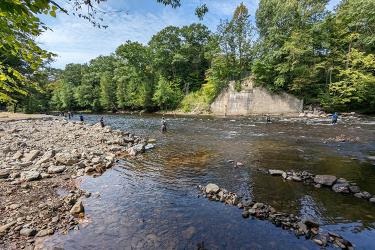Think about taking that first bite of a perfectly prepared flounder dinner. Maybe it’s baked with some garlic, butter and lemon, stuffed with crab meat —or, for the taco enthusiast, blackened and grilled with mango salsa on a corn tortilla. Is your mouth watering yet? Whichever way you are picturing this delicious meal, have you ever stopped to wonder about this white, flaky fish on your plate? What does it look like? Where does it come from? If you have, then it’s time to dive in.
A Mug Only Picasso Could Love
The winter flounder, also known as sole, has developed numerous traits that give it a truly distinctive appearance. The most obvious feature is its flat, thick, pancake-like shape, adapted for life on the sea bottom. The lower half of its body, which skims along the ocean floor, is generally lighter in color than the upper half. The exposed part of its body may be green, gray, or brown, and may or may not be patterned. Like octopus, the winter flounder has skin that can change color and blend in with its surroundings.
The bottom-dwelling lifestyle of this flatfish contributes to its oddest characteristics, a tiny mouth and both eyes on one side of its head. Fun fact: a flounder larvae is born with an eye on each side of its head. As it grows and adapts to a bottom-living lifestyle, the left eye migrates to the right side of its body.
Getting to the Bottom of It
Winter flounder migrate between offshore and inshore areas into shallow estuaries. They live along mud, clay, sand, or pebble sediments, and prefer sandy bottoms to lay their eggs. Females produce between 500,000 to 1.5 million eggs within estuarine waters 20 feet or less. Coves and bays surrounded by vegetated marsh provide excellent nursery habitat for flounder to grow before they are large enough to migrate into deeper waters. Softer bottom sediments also allow flounder to partially bury themselves for protection and to capture small benthic invertebrates, such as worms and crustaceans, for food.
Won’t They Freeze?
Most fish are cold-blooded, which means their body temperature is regulated by the surrounding water. Unlike many other fish, winter flounder actually prefer the cold. In fact, the name “winter” flounder refers to their annual winter migration into cooler nearshore waters. Adults spend their lives chasing the cold water, spawning in shallow estuaries during winter, and keeping cool in deeper offshore waters in the summer. Ideal living and spawning temperatures range between 32°F and 50°F, but winter flounder can survive temperatures near 28.4°F, the freezing point of seawater. How? They have a special “antifreeze” protein that makes them freeze resistant!
Vulnerable but Manageable
The cold water lifestyle helps to limit predators that prefer warmer waters during early life stages. However, winter flounder populations have been in decline since the mid-1980s in the Greater Atlantic Region due to overfishing, pollution from runoff, and warming waters. With the New England Fishery Management Council, we jointly manage winter flounder and twelve additional “groundfish” species under the Northeast Multispecies Fishery Management Plan. The plan ensures that these fish are sustainably managed and responsibly harvested.
We’re experts on the sensitive early life stages, spawning habits, and habitats winter flounder need to survive. This allows us to better manage human activities, such as dredging and development, by providing advice to minimize or prevent impacts. For example, to protect eggs during the spawning season, we recommend avoiding dredging operations between January and May in shallow coastal waters. These activities could bury or destroy eggs laid on the bottom. We also work to protect and restore coastal marshes that help keep the water clean and provide food and shelter for these growing fish.
As you feast on your next flounder this winter, think about them living their best life in the cold.




